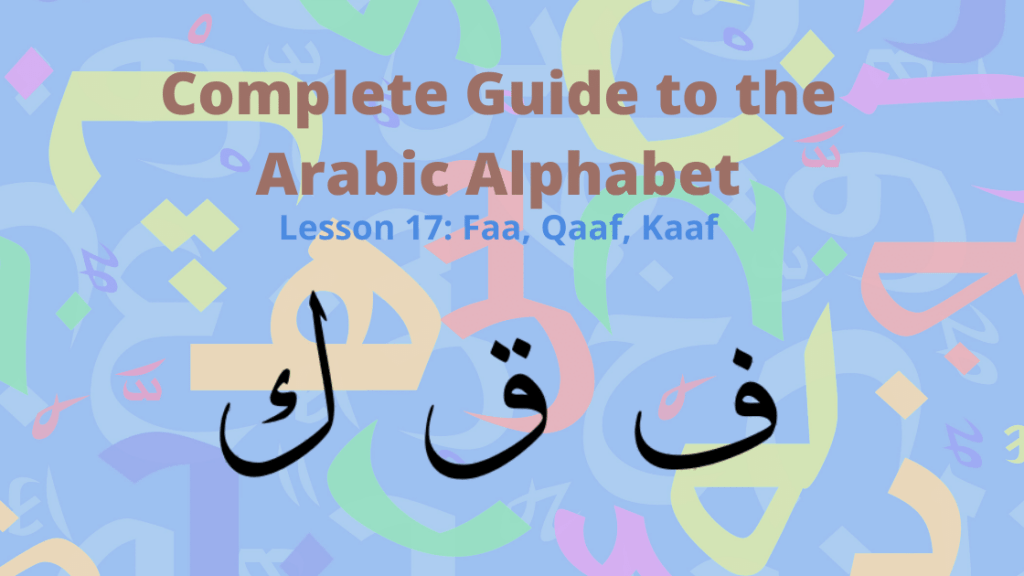The Letters Faa,
Qaaf and Kaaf

· The next letters of the Arabic alphabet are Faa, Qaaf and Kaaf
| ف |
| ق |
| ك |
·
These letters don’t really
look the same
And only two of them sound the same
But they are typically grouped together anyways
·
Faa is equivalent to the
English letter F
Qaaf is represented by the letter Q; it sounds like K except it’s “deeper”
Kaaf is equivalent to the English letter K or C
Listening & Pronouncing
· Faa sounds exactly like F
· Exercise: do you hear a Faa in the following recordings?
| Answer [NO] |
| Answer [1] |
| Answer [2] |
·
The sound of Qaaf is close
to the sound of K
But here’s how you really pronounce it:
Make the K sound
Note which part of your tongue hits the roof of your mouth
Don’t use this part; use a part of your tongue further back than this
The back of your tongue should be hitting the opening of your throat
· Exercise: repeat the words you hear
|
|
|
·
Kaaf sounds exactly like K
The same part of your tongue hits the same area on the roof of your mouth as
when you pronounce K
· Exercise: which recording in each pair has the Qaaf, and which has the Kaaf?
1 |
| Answer [3 Qaaf] |
| Answer [1 Kaaf] |
2 |
| Answer [1 Qaaf] |
| Answer [2 Kaaf] |
3 |
| Answer [2 Qaaf] |
| Answer [2 Kaaf] |
Reading & Writing
end | middle | beginning | by itself |
ـف | ـفـ | فـ | ف |
ـق | ـقـ | قـ | ق |
ـك | ـكـ | كـ | ك |
·
Faa and Qaaf look the same
in 2 of the 4 cases (a small loop)
But remember, sometimes you differentiate letters by the body, and sometimes
you differentiate them by the number and position of the dots
Faa has 1 dot and Qaaf has 2 dots
· Plus, when the letter is by itself or at the end, the Faa tail is long and the Qaaf tail is round
· Kaaf is like a backwards L
·
Kaaf has a special squiggle
instead of a dot
This squiggle goes away when it’s in the middle or beginning of a sequence
·
When Kaaf is in the middle
or beginning, the body kind of changes
It looks like a giant < (less than) sign
Or kind of like an S
·
Exercise: read the
following words to the best of your ability
Some letters will be new
Learn to recognize what you’ve seen and what you haven’t
|
عَقْعَقِ |
فُرْقانَ |
تَضَرُّعْ |
|
كَفالَةِ |
سَفَرْجَلْ |
طُفْرُ |
|
إِشْتَبَكَ |
سُكَّرْ |
كافَّ |
|
فِرْقَتُكْ |
حَبَطِقْطِقْ |
سُرادِقُ |
· Exercise: write the word you hear
| Answer [تَقَرُّرْ] |
| Answer [تَكْرارْ] |
| Answer [قَفْرِ] |
| Answer [قَرُبَ] |
| Answer [كَرُبَ] |
This lesson was authored by Mohtanick Jamil
FREE Course
-
LEVEL 1
- 1 About the Arabic Alphabet
- 2 Letter Aleph
- 3 Letters Baa, Taa, THaa
- 4 Vowel Fatha
- 5 Lesson Review
- 6 Letters Jeem, Haa, KHaa
- 7 Reading & Writing Review
- 8 Letters Daal, Dhaal
- 9 Letters Raa, Zeiy
- 10 Pronunciation Review
- 11 Letters Seen, SHeen
- 12 Letters Saad, Daad
- 13 Vowels Kasra, Damma
- 14 Letters Taa, Zaa
- 15 Letters Ein, GHein
- 16 Arabic Syllables
- 17 Letters Faa, Qaaf, Kaaf
- 18 Letters Laam, Meem, Noon
- 19 Rest of the Alphabet
- 20 Review & Practice
- 21 Double Vowel
- 22 Reading Arabic Sentences
LEVEL 2
LEVEL 3
LEVEL 4
LEVEL 5